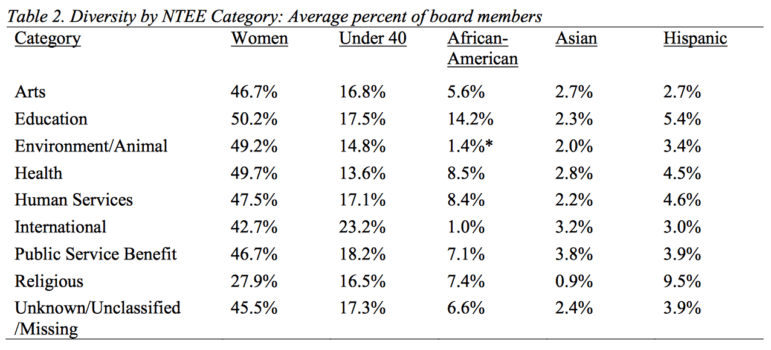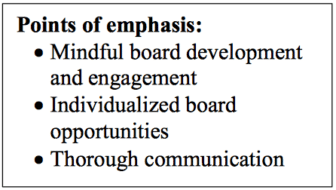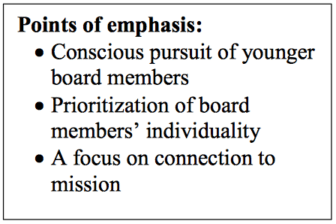
We love BoardSource’s habit of optimizing the use of the data it collects in its biennial survey of board members and executives. Most recently, it collaborated with the Lilly Family School of Philanthropy at IUPUI and Johnson, Grossnickle and Associates to produce a report—The Impact of Diversity: Understanding How Nonprofit Board Diversity Affects Philanthropy, Leadership, and Board Engagement—that examines what other organizational characteristics correlate to board diversity and what effects that diversity arguably has. As it turned out, little in the report was definitive, but the case studies, two of which are reproduced here as written in the report, provide guidance for the kinds of integrated strategies that can make a difference in individual nonprofits.
What Correlates with Increased Board Diversity?
Two correlates to racial and ethnic diversity stood out in the report’s findings—organizational age and budget. In short, the older the board and the higher the budget, the lower the levels of diversity.
Older organizations are also likely to have higher levels of board involvement in fundraising. In fact, the oldest organizations—especially those founded before 1900—had significantly higher percentages of board members who met with potential donors, asked others for money, and contributed themselves.
Those older organizations, according to this study, also tend to have higher board member engagement. “In particular,” the authors write, “boards of organizations founded prior to 1900 were significantly more likely to be rated as highly committed and involved by their CEOs. But from there, it gets really interesting…
However, boards with higher percentages of African-Americans tend to have lower board member engagement in governance and were less likely to be rated as highly involved by their CEOs. We explored this relationship more deeply and found that it appears to be driven by results from older organizations and organizations with higher revenues as this decreased board member engagement was not found to be true in smaller, newer organizations. There is no relationship between the percentage of African-Americans on the board and board member engagement among smaller, newer organizations. The data does not provide insight into why this may be, but it is possible that the culture of older organizations and organizations with higher revenues may make it a challenge for new board members to participate.
Thus, although larger and older organizations may be able to diversify, they appear to still have trouble engaging and including that newly built body. This suggests that all nonprofits—even the old and well resourced—must be tasked with figuring out not how to recruit a diverse board but how to build the systems to engage with and include a diverse community in and around the organization.
The study found some distinct differences in diversity based on fields of practice, as can be seen in the chart below. Each category and column tells a mini-story through the numbers.

The boards of arts and culture organizations were described as being more likely to actively participate in fundraising “than the boards of health, environmental/animal, and internationally focused organizations. Measures of race, ethnicity, gender, or board member age were not significantly associated with any other measures of fundraising.”
In terms of demographics, the more women on board, the more advocacy was likely to be done. But only one organizational characteristic is truly associated with advocacy engagement, and that’s the organization’s revenue.
The following two miniature case studies, reflecting a clear focus on board transformation in two very different situations, are taken directly from the report. As you read them, consider how the composite ideas might be applied to your own organization.
Emerging from a merger with high board member engagement
Como Friends
More and more nonprofits are undergoing mergers as a way to keep their organizations viable and increase mission impact.
Como Friends was created by uniting four Minnesota nonprofits in the 1990s and, thanks in part to a strategic approach to diversity, individualized board opportunities, and clear expectations of board members, it has emerged as an organization that is stronger than ever.
Como Friends exists to support the Como Park Zoo and Conservatory, a beloved St. Paul/Minneapolis institution with roots dating back to 1897. The most-visited cultural institution in the state of Minnesota, Como Park Zoo and Conservatory welcomes more than two million annual visitors, appealing to a broad audience with a strong brand, free admission, and an accessible location.
Originally two separate entities, Como Park Zoo and Conservatory has had the support of several docent and support groups dating back to the 1960s. In the 1990s, as interest in creating a Visitor’s Center promoted the merger of the Zoo and Conservatory, the four primarily volunteer nonprofits supporting these two entities also merged, forming Como Friends.
Despite its eventual success, the merger did at first create concern because those who served had great passion for the organizations and not everyone could be as involved as they wanted to be with the new structure. The group made the best decisions possible given the situation and worked hard to build strong board relationships. Como Friends has not looked back.
Since 1999, Como Friends has provided more than $38 million toward capital projects and community programs, including the Como Park Zoo and Conservatory’s Visitor Center, Tropical Encounters, Polar Bear Odyssey, and Ordway Gardens. This success can be attributed to a couple of key factors. Certainly, consistent leadership plays a role: The current president has been in place since the organization was formed.
But board strength is also an important part of the formula, and the strength of Como Friends’ board is the product of a mindful board development and engagement process.
This process starts with recruitment. Como Friends is working hard to ensure that its board mirrors the diversity of the community, convening a governance committee that considers a wide range of factors when recruiting members. Term limits allow frequent opportunities to refresh the board and keep new energy and viewpoints rotating into the group.
When a new member joins the 29-member board, the Como Friends staff engages him or her quickly in the life of the Zoo and Conservatory. Orientation is thorough, informing new board members about past accomplishments, goals for the future, and clearly defined board expectations.
Sign up for our free newsletters
Subscribe to NPQ's newsletters to have our top stories delivered directly to your inbox.
By signing up, you agree to our privacy policy and terms of use, and to receive messages from NPQ and our partners.
For Como Friends, this process of board member engagement involves encouraging each board member to contribute to the work of fundraising, advocacy, partnerships, and/or community outreach in a manner best suited to his or her skills. Board and staff leadership work hard to help each board member find his or her sweet spot through a robust committee structure that offers a variety of opportunities on both standing and ad hoc committees. Board and staff leadership trust the committees to do their respective work, all of which is aligned with the strategic plan. The executive director notes that investing in strategic plan development was one of the best investments Como Friends has made. The process engaged board and staff, helping the organization take a significant step forward with achievable goals and specific tactics to reach them. As leaders within the board plan to transition out of their roles, other members overlap in serving with them to learn from their expertise.
Because the Como Friends board is so large, thorough communication and frequent engagement is essential. Board members are consistently informed about Zoo and Conservatory improvements and the benefits they provide to visitors, from conservation education for students to the restoration of the Japanese gardens. They also are included in celebrations of gifts, grants, births of animals, as well as unique, immersive donor events.
Board members report that receiving consistent and frequent communication helps make board meetings more efficient. In a related effort, the board also has been trying to maximize meeting time for busy members by using breakout sessions that allow board members to discuss multiple points of an overarching topic in smaller groups and then report back to the full board.
With these mindful approaches, Como Friends has overcome initial merger pains to become an entity greater than even the sum of its four parts.
Attracting and developing young board leaders
United Way of Abilene
A conscious pursuit of younger board members has combined with clear expectations to help the United Way of Abilene evolve into a stronger organization that meets the needs of the West Central Texas residents it serves as well as the people who serve on its board.
This evolution has come in part as a result of its leader’s recognition that change was needed. Several years ago, CEO Cathy Ashby noted that her organization lacked young donors. Knowing that demographic would be integral to growing the organization and increasing its revenue, she sought to remedy this shortcoming.
The organization she was working to change had a long record of success. Founded in 1956, the United Way of Abilene serves 19 counties in West Central Texas and works with 27 partner agencies. Focusing on the building blocks of life—education, income, and health—it seeks to collaborate with the community to create lasting change.
The residents of the community it serves love their city and want to serve. In fact, the city of approximately 100,000 supports more than 600 nonprofits, meaning residents have plenty of opportunities to engage and serve. Young people, in particular, have responded, and Ashby wants them to see the United Way as a leading opportunity for service.
To achieve this, she and her board took a number of steps.
First, Ashby recognized that younger people like to be engaged in different ways, so she recruited more board members capable of connecting with the 20-to-40 age group. She also acknowledged that younger generations want to connect to mission, actively serve the community, and still accommodate a full personal and work life. As such, her organization seeks to respect board members’ individuality, taking the time to get to know each board member and align organizational opportunities with his or her individual interests. In addition, Ashby and her board work to continuously engage new and younger board members.
Also, the United Way of Abilene has intentionally linked its board to the Young Leaders Society, a committee for community leaders 40 and younger, by placing the chair of the Society on the board’s executive committee. This gives the young members of the Society a voice, and creates a connection to young up-and-coming leaders.
The result? Today, 21 of the board’s 30 members are in their 30s or 40s.
But this process goes beyond board recruitment. The United Way of Abilene also ensures that younger board members have meaningful board experiences.
New board members are matched with mentor members for their first year. With expectations as simple as sitting together at meetings (to ensure attendance and answer questions), these pairings help newer, younger members understand the board culture.
In addition, every board member is required to serve on the Community Impact Review Team, an allocation committee known as CIRT. This entails evaluating organizations seeking funding, reviewing partner organizations, and conducting site visits that culminate in final recommendations on grant funding, all of which puts board members on the front lines of the work being done in partner organizations and gives them first-hand exposure to the mission of the United Way of Abilene.
CIRT is also used as an effective recruitment tool for younger board members because, as a committee open to non-board members, it allows the United Way of Abilene to meet and work with individuals who might be a good fit for the board in the future.
The focus on the individual extends beyond recruitment. Board members spend time learning about each other, and each board member is empowered to do what he or she is most interested in to make a difference. These passions are identified in interviews between individual board members and Ashby, who talks with each board member about what he or she is good at and would like to do.
In addition, individual achievements are recognized: If someone is honored in the community, he or she will be celebrated in a board meeting, where “member spotlights” highlight board members’ accomplishments.
To ensure all board members remain connected to partners’ missions, each year, United Way of Abilene has an annual full-day board retreat during which partner organizations are reviewed and site visits are conducted.
The result of this intentional pursuit of younger members and ongoing support of members is a board that is strong and well-equipped to serve the needs of the community its members so cherish.











